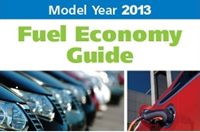Learn About the New Label
Greenhouse gas emissions from vehicles are an important contributor to climate change.
Visit EPA's climate change page for more details.
View a video about the new labels.
Click on a tab to view the new labels for various vehicle/fuel types. Move the cursor over parts of the label to learn more.


































See all the labels, including diesel, FFV, CNG, and fuel cell: All Labels (PDF) (10 pp, 236 KB, About PDF)
Visit EPA's website for more information on the new label regulations.
Beyond Tailpipe Emissions
Driving your vehicle can yield both greenhouse gas (GHG) emissions from your vehicle's tailpipe and GHG emissions related to the production of the fuel used to power your vehicle. For example, activities associated with fuel production such as feedstock extraction, feedstock transport to a processing plant, and conversion of feedstock to motor fuel, as well as distribution of the motor fuel, can all produce GHG emissions. continue reading »
Learn more about GHG emissions for different fuels.

















